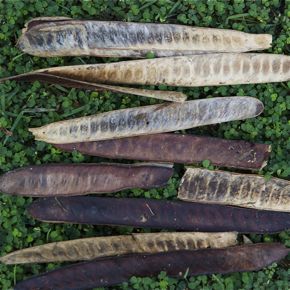Tan Teo Seng observed a pair of adult Oriental Pied Hornbills (Anthracoceros albirostris) busily hopping from branch to branch of a leucaena (Leucaena leucocephala) tree, also known in Malay as petai belalang. The hornbills were pecking at the ripened pods of the tree, trying to get at the seeds. This resulted in bunches of fruits falling to the ground below (left).
They then flew off to a nearby horse-radish (Moringa pterygosperma) or drumstick tree and also tackled the ripened pods, apparently to get at the seeds. Again, many of the disturbed pods landed on the ground (below).
The ripened seeds of both these legumes are hard and this leaves one to wonder whether the hornbills were actually eating the seeds.
Teo Seng did not see the hornbills actually throwing the seeds from the bill tip directly into the throat. Thus in the absence of such a behaviour, was the hornbills actually eating the seeds? Teo Seng will be keeping a close lookout for such behaviour the next time.
The observations were made in late May 2010 in a fruit farm in Kota Tinggi, Johor, Malaysia. It was raining heavily then and the adult hornbills were foraging in the rain. The juvenile that was with them did not join in but remained under the shelter of the house.
Images by YC Wee.











3 Responses
Dr Pilai Poonswad has written to the effect that she has never seen Oriental Pied Hornbills eat hard seeds, except when these seeds are covered with a layer of aril. Hard seeds are non-digestible and take up space in the stomach.
Moringa: The moringa leaves are an excellent source of nutrition. People commonly boil the tiny leaflets and eat them like spinach. This will help them in increasing nutrition content in the body.